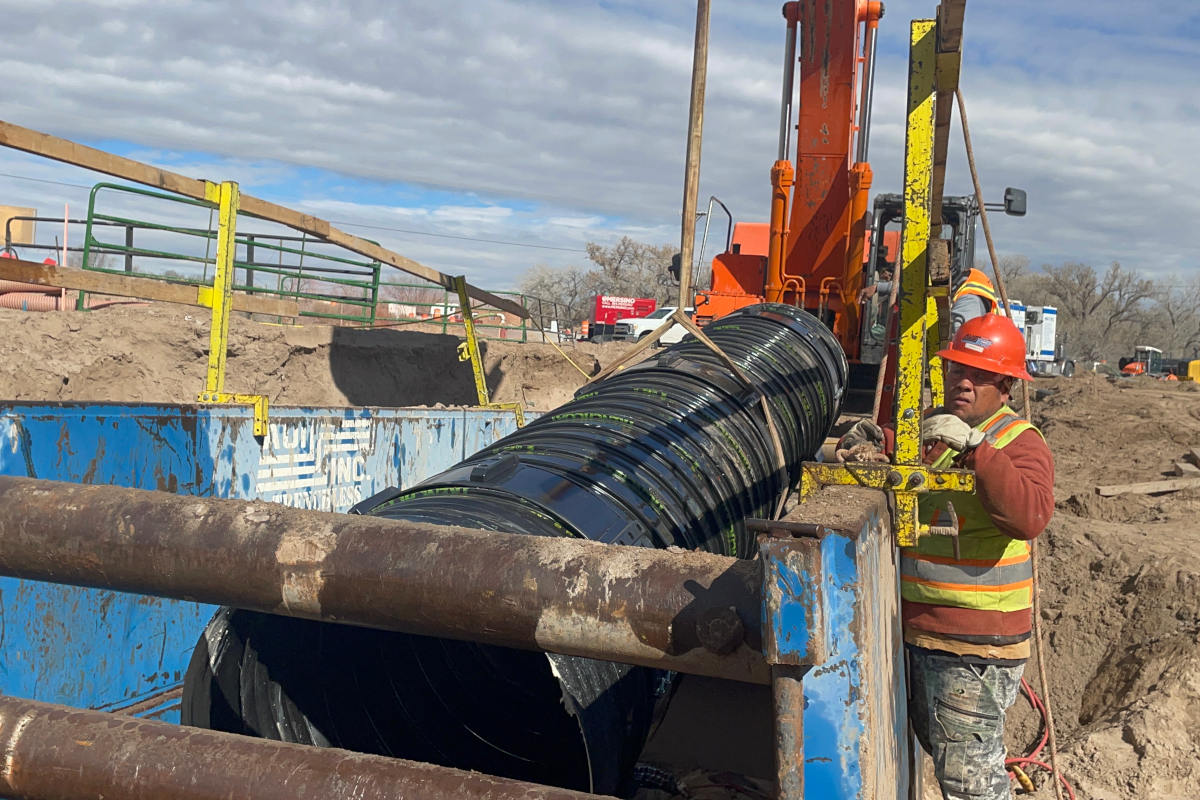
2021 Trenchless Technology Project of the Year Rehabilitation Honorable Mention: Cottonwood Siphon Slipline Project
Project Details – The Cottonwood Siphon Rehabilitation Project was a joint works project between Northern Colorado Water Conservancy District and the U.S. Bureau of Reclamation. The siphon, constructed in the 1950s, carries Colorado-Big Thompson Project water (a Trans-Continental Divide Project) to users along the Colorado Front Range and ultimately to Horsetooth Reservoir.
It was determined that the siphon was structurally distressed beyond serviceability limits and required rehabilitation to provide continued service. Several design elements contributed to a highly functional and effective project outcome. First, construction and installation of the slip line repair was minimally invasive to the project site compared to other possible alternatives such as rebuilding the siphon completely, which would require removal of a county road bridge and significantly higher cost. Second, some appurtenant features of the infrastructure had to be removed for installation of the steel pipe sections which then allowed for more modern and useful replacements of those features to be installed. Finally, the effectiveness and longevity of the design was key to both preserve flow rate and extend the life of the siphon well into the future.
Maintaining the original flowrate was key to ensuring the vast range of operational scenarios for the system and although the diameter was reduced slightly, the design achieved original flow rate capacity easily and ensured continuity for water user demands and power generation needs. The project scope involved sliplining of a 142-in. steel liner into the existing tunnel over a distance of 250-plus lf within the existing concrete liner. To do so, 28 individual prefabricated steel casing rings that are curved in both line and grade were placed and welded on-site. They were then grouted and epoxy coated. Although larger diameter steel slip-line projects are not that uncommon, this steel slip-line installation did pose unique challenges due to the very large diameter (140- and 142-in.), the degree of the siphon slopes, and the necessity of constructing the slip-line through the siphon elbows. The project team addressed these items through a detailed design and verification of design effort, including 3D laser surveys of the existing siphon pipes, some unique design components (slip-line anchors, terminations), careful coordination with the large diameter steel pipe manufacturer, and highly orchestrated installation methods from both sides of the siphon.
Why Project is Outstanding
Beyond the expected challenges of a highly specialized, complex heavy civil project and the impact of the ongoing COVID-19 pandemic, the historic Cameron Peak Wildfire became a major incident to overcome. The fire’s rapid spread resulted in the project area being designated a mandatory evacuation zone, even though the fire was still one mile away. As Estes Park had been evacuated, the Western Area Power Authority (WAPA) was considering cutting power to transmissions lines serving Estes Park to prevent possible damage to live wires. If this were to happen, it would have a significant impact on the fire-fighting efforts in the vicinity. Additionally, with water transmission from the transcontinental tunnel and canal system being shut down from the rapid spread of a different wildfire called the East Troublesome Fire, the two Bureau of Reclamation powerplants in Estes Park were not generating electricity. However, because the Cottonwood Siphon Project had been substantially completed the Friday when all the above was unfolding, the Bureau of Reclamation and Northern Water determined water conveyance in the siphon needed to be turned on immediately for Estes Park power generation needs. Northern Water contacted UIT late in the evening on that same Friday to propose a site visit the following day. The project team was granted access to the site and with a law enforcement escort assembled at the site on Saturday to perform the final inspection. After approval, the project team worked to secure the site while facing 70 mph wind gusts and smoke plumes. Water conveyance was then restored back online and power generation under way within six hours of removing the lockout-tagout clearance. In the end, all project team parties involved were able to meet the challenge and water-up quickly on a Saturday with little notice.
Project Owner: Northern Colorado Water Conservancy
District Engineer: Dewberry
Contractor: Underground Infrastructure Technologies LLC
Value of Trenchless Project (US$): $2,201,930




